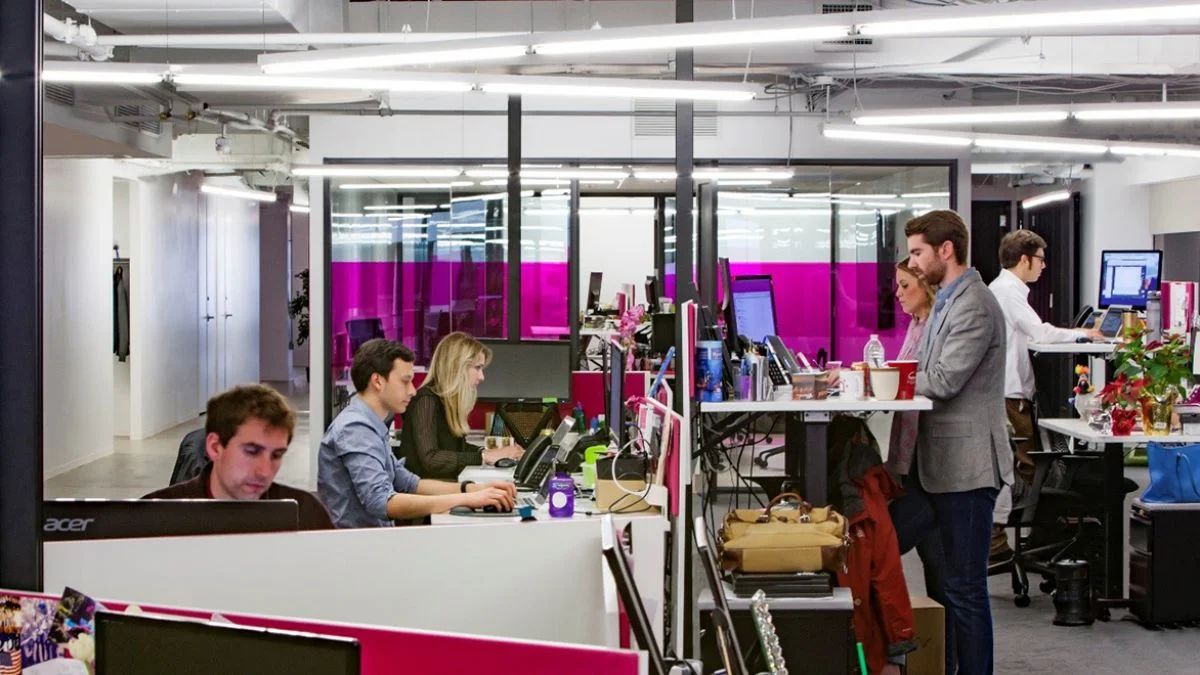Where does Detroit’s most recognized real estate company work? Located in between the First National Building and the Vinton Building, Dan Gilbert’s Bedrock purchased the handsome Metropole Building in 2013. The four-story building had been largely vacant for 47 years, except for the Bangkok Crossing restaurant on the ground floor.
So Long Conference Room! How Microsoft Envisions the Future Office
If you take the door off the conference room, will the meeting be just as productive? That’s a question Microsoft, in collaboration with San Francisco–based Studio O+A, is hoping to answer. The two have partnered for the design of Microsoft’s Envisioning Center, an evolving space for testing prototypes at the tech company’s Redmond, Washington, headquarters. Unlike most testing facilities, however, the Envisioning Center isn’t a lab, but rather a fully designed environment where both in an active setting. In this case, that setting is the office of the very near future.
Peak Performance
A considered approach to office design could help employees become even more productive - so why are so many companies still getting it wrong? Organizations are realizing that they are fighting a war for talent. As that intensifies, employees are behaving more like customers, being choosy about who they work for and looking for organizations that convey particular values and culture through their workplace. What they’re looking for is more humanity in the office and environments that energize them and connect them with the organizations values – and one another.
ATTRIBUTES OF BUILDINGS OF THE FUTURE AND THEIR IMPACT ON WORKPLACE DESIGN
Buildings are by far the most permanent part of the workplace. With an average lifespan of about 80 years, many buildings outlive the occupants they serve.
Recent construction trends favor wild designs, featuring buildings that push the boundaries of engineering, market return and consumer popularity. Buildings are also redefining height limitations; at least eight of the world’s tallest buildings are planned to top out within the next five years.
How A Well Designed Meeting Room Can Foster Collaborative Learning
When planning an office design project, it is surprisingly common for businesses to neglect the design of their meeting rooms. After all, in a typical office building, meeting rooms are not in constant use and many facility managers take the approach that the room simply needs to be big enough to fit people in.
Digital Transformation: Using Augmented Reality to Experience Design
The new reality of design is here, and it’s virtual. Creative imagination allows our clients to experience completed spaces in any stage of the design process. With the technology becoming faster and less expensive, it allows us to take the digital assets we are creating during the design process and evaluate them in the context of their environment.
WILL GENERATION Z ALTER THE DESIGN OF THE WORKPLACE?
International architects firm HKS conducted a yearlong research study to find out the future of the workspace. They based their research on Generation Z.We have all heard of Millennials, well for better or worse - their reign is coming to an end. So, let me introduce you to their replacements - Generation Z.
Reducing office square footage creates a spider web effect
Amongst the goals, concerns, and aspirations of our clients shaping workplace design today, there are two constants: money and space. In today’s budget-conscious environment, reducing square footage is one of the primary drivers for new workplace design. Firms and organizations like the idea of moving to a smaller space and saving money on their lease. In fact, reducing square footage is probably the No. 1 goal I hear about today when we start working on a new office. Square footage requirements balanced against program needs drive the design discussion.
The Future of Office Design: Nature-Inspired, Tech-Enabled and Privacy On-Demand
Workplace design is more than just armchairs and lobby couches: Studies have shown that a well-designed workspace and furniture can boost employee productivity and happiness (all which can impact the organization's bottom line).
The Dynamic Work Environment
As millennials pour out of college eager to find jobs, commercial real estate costs per square foot rise, and businesses continue to expand in our growing economy, the office design industry continually sees an increase in our ever-changing office environment.
The "Human" in Human-Centered Design
A Human-Centered Design process simply means that we design for the humans who will use the solution. Design is not based on our preconceived notions of what an effective learning environment is or those “me too” inclinations. Human-Centered Design creates the “why” and also lays the foundation for authentic creation.
Will an open office environment work for you?
Though people still talk about the corner office as a benchmark of success in the workplace, more and more companies are tearing out cubicles and private offices in favor of open floor plans with flexible furniture. The potential benefits of open offices—flexibility, opportunities for collaboration, and reduction of hierarchies—are appealing to companies that want to encourage innovation, but some projects require a level of focus best obtained in an enclosed, private space.
The five secrets to mastering workplace design
The primary purpose of a well-designed workplace is to nourish personal energy—individual comfort and well-being, to maximize employee potential and productivity. Next, workplaces are tools to build organizational capital, i.e. to strengthen and shape work cultures, structure and processes. Third, an office is a potent platform to communicate brand values. And finally, some progressive leaders have begun to think of workplaces as a resource to sustain the environment.
How Furniture can affect productivity and Wellness in Workers
Being able to quickly and easily interact with co-workers is vital in an office setting, and being able to move your desk around allows one to do so without disruption. Increased flexibility ultimately allows the employees to accomplish more throughout the day and be more productive in the long run.
EMPOWERING CREATIVE EXPRESSION
At NeoCon 2017, we discussed creative expression and shared new custom capabilities in the Coalesse showroom. We believe engaging the design community in customizing our products can empower more personalized and meaningful outcomes.
"Apple's new campus sucks" according to Wired magazine
"By building a mega-headquarters straight out of the middle of the last century, Apple has exacerbated the already serious problems endemic to 21st-century suburbs like Cupertino – transportation, housing, and economics."
Riffing on the issue of workplace design and creativity
We are often told that one of the main objectives of workplace design these days is to help people become more creative. Now, there are all sorts of complications bound up in this, not least the assumption that you can help or even will people to become more creative, especially in an environment that still wants, in some way at least, to supervise what they do and when and where they do it. A working environment designed for creativity only works in the context of a culture that facilitates it. And here’s where the problem lies. Some traditional and proven avenues to creativity should remain closed to workplace occupiers and designers – not least misery and drugs – so that leaves them with a bit of a challenge.
3D printing and Virtual Reality could reduce waste in design and construction says BCO
Digital technologies such as Virtual Reality (VR) and 3D printing could help reduce waste during a design and construction project, suggests a new report from the British Council for Offices (BCO). “Virtual Reality and 3D Printing – Reducing waste in office construction through new technology” reviews the existing applications of these technologies and their ability to mitigate waste during the design and construction process.
Decibels and Cubicles: The Challenge of Workplace Noise
How loud is too loud? Well, that depends.
Workplace noise (and its effects on employee health and performance) has been a topic of research since at least the first half of the 20th century, but despite the attention given to the issue, the challenge remains a thorny one.
The Workspace Of Tomorrow: Part 2
Every building has to meet several basic requirements such as security, fire-life-safety, ventilation, lighting, health and comfort. The systems required to provide these building control services are collectively known as building automation systems (BAS). The biggest challenge facing the BAS industry is the myriad of protocols that exist within the industry. The result is a world in which systems that perform similar functions cannot communicate with each other.

























